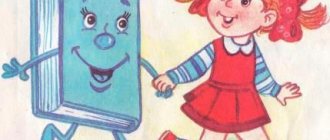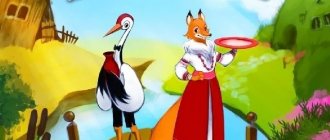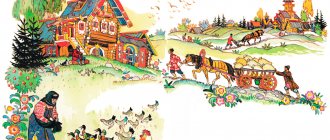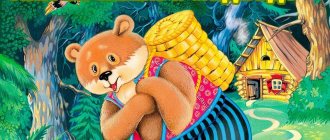Educational and game project "Turnip"
Bibliographic description:
Burtseva, S. E. Educational and gaming project “Turnip” / S. E. Burtseva, T. M. Smirnova. — Text: direct // Questions of preschool pedagogy. - 2022. - No. 6 (23). - pp. 14-16. — URL: https://moluch.ru/th/1/archive/128/4260/ (access date: 01/03/2022).
Participants: Teachers, parents, children of the younger group
Main idea and relevance:
Our kids really liked the Russian folk tale “Turnip” and, at their request, we read it many times. And then one day the children asked: “What is a turnip?” Then we decided to introduce the children to the turnip, tell them that it is a vegetable, and pay attention to the color, shape, taste, and smell.
The children were very interested in studying the turnip; they began to play with the turnip; for this, the parents brought various turnip-themed toys (laces, inserts, puzzles, stencils) to the group. We also drew, sculpted, and mosaiced the turnip.
We tried to plant a turnip together with the children, “like grandpa.” The children sowed the seeds themselves, and every day they watched the shoots appear and new leaves appear.
Our group has a magnetic puppet theater made by our graduates, the kids also played with pleasure in it. And then we decided to try to make a cartoon on the theme of turnips.
Goal : To create conditions for the development of children’s cognitive and creative abilities in the process of studying turnips.
Tasks:
Educational:
- Teach children to ask questions and look for answers with the help of adults.
Educational:
- Develop children's speech and ability to hold a conversation.
- Develop attention and imagination.
Educational:
- Foster friendly relationships between children; the habit of playing, working, and studying together.
- Cultivate respect for the work of peers, the desire to come to the aid of a friend.
Resource support:
Books with illustrations for the Russian folk tale “Turnip”, vegetable - turnip, plasticine, modeling boards, colored pencils, gouache paints, brushes, water jars, watercolor paper, accessories for sowing and growing plants: soil, seeds, scoops , watering cans, containers for seedlings, magnetic puppet theater, camera, computer.
Expected results:
Children will learn what a turnip is, learn to draw and sculpt it, sow seeds and grow seedlings on their own. The children will get acquainted with a magnetic puppet theater and take part in filming a cartoon based on the Russian folk tale “Turnip”.
Methods and means of implementation:
| Educational areas | Joint activities of children and teachers | Joint activities of children and parents | Independent activities of children |
| Social and communicative development | Conversation with children: “What is a turnip? Where does it grow? Conversation with children: “What is it like, turnip (color, shape)” Game "Harvest". Game “Polite words” (how to ask a friend for help and thank you later?). | Meeting of the children's and adult club "Zadorinka" - topic: "Turnip". A fairy tale dramatization by parents for children. | Looking at the book corner books with illustrations by different artists for the fairy tale “Turnip” |
| Cognitive development | GCD “Introducing children to the concept of “vegetables”, “Introducing children to turnips, studying the shape, color, smell, taste”, “Introducing children to turnip seeds, how they grow and what they need for growth and development.” “Sensory development in the process of becoming familiar with the turnip vegetable (laces, puzzles, stencils, inserts" A visit to the play in the senior group “Turnip - an old fairy tale in a new way.” | A visit by parents and their children to the puppet show “Russian folk tales for little ones” at the puppet theater. | Didactic games “laces, puzzles, stencils, inserts” Cutting pictures “Collect a turnip”, “Collect the heroes of the fairy tale “Turnip” Laying out mosaic turnips. |
| Speech development | GCD Reading the Russian folk tale “Turnip” to children, answering the teacher’s questions, retelling the tale. Showing the finger theater "Repka" to children Conversations about the fairy tale "Turnip". | Meeting of the children's and parent club "Zadorinka" - topics: "Turnip dishes" "How to grow turnips in your garden, varieties of turnips, secrets of growing." "Turnip as the main vegetable in Ancient Rus'." | Looking at books with the fairy tale “Turnip” in the book corner, talking about the fairy tale, retelling the fairy tale. |
| Artistic and aesthetic development | GCD Drawing: “Turnip” with gouache, “Coloring a turnip with colored pencils” “Coloring illustrations for the fairy tale Turnip” Modeling: “Plasticine picture – “Turnip”, “Modeling from turnip plasticine” Application: “Turnip”. | Homework: draw a turnip together with your parents, invent and make turnips from different materials. | Drawing on the topic “Turnip” in free time. In the book corner, look at illustrations and reproductions by various artists on the topic: “Turnip” |
| Physical development | Outdoor games during a walk: “Round dance of vegetables”, Russian folk game - round dance “Grow a turnip, Grow strong" Physical education - minute "Turnip". | Meeting of the adult-children club “Zadorinka” “Mom Dad I am a sports family (games and relay races on the topic: “Harvest the harvest”). | Outdoor games in free time of children's choice. |
| Implementation stages | Deadlines | Activities | Target | Performers |
| Preparatory | September - December | Reading to children the Russian folk tale “Turnip”, adapted by different writers, listening to audio recordings of the tale performed by famous actors. Introducing children to vegetables. The teacher's story about how turnips grow. Examining turnips, studying their shape, color, smell, taste. Drawing and sculpting turnips. | Introduce children to the Russian folk tale “Turnip”. Introduce children to the concept of “vegetables” and to turnips as a vegetable crop. | Teachers, children, parents. |
| Basic | January March | Introducing children to turnip seeds. Sowing turnip seeds, watering. Observing the appearance of sprouts, caring for seedlings, preparing for planting them in the garden. Introducing children to magnetic theater. Learning roles. Shooting a cartoon. | Teach children to sow seeds and care for seedlings. Teach children to move magnetic theater figures and participate in filming a cartoon. | Teachers, children, parents. |
| Final | April | Showing a cartoon to children of another junior group, parents and employees of the complex, telling the children about how they planted turnips. | Introduce children from another younger group to how you can grow turnips from seeds yourself. Show the filmed cartoon. | Children Educators, parents. |
Final activities:
Showing the cartoon to children of other groups, parents and employees of the complex. Outdoor leisure “Our “Turnip”.
Reflection:
The children got acquainted with the Russian folk tale “Turnip”, as well as with turnips as a vegetable crop. Children learned to draw and sculpt it, sow seeds and grow seedlings on their own, and also learned what a plant needs for growth and development. The children got acquainted with a magnetic puppet theater and took part in the filming of a cartoon based on the Russian folk tale “Turnip”.
We believe that this child-adult project had a beneficial effect on the development of children’s cognitive, research and communication abilities. The project also helped to unite children and begin to form a children's community.
Literature:
- From birth to school. Basic educational program of preschool education. Ed. Veraksy N. E., Komarova T. S., Vasilyeva M. A. M.: “Mosaic-Synthesis” 2015.
- Propp V. Ya. “Russian fairy tale” M. “Labyrinth” 2011.
- Propp V. Ya. “Morphology of a Fairy Tale.” M. “Labyrinth” 2011.
- Propp V. Ya. “Historical roots of a fairy tale” M. “Labyrinth” 2011
- Vegetables, fruits, berries. Encyclopedia in pictures. M. "Rosman" 2014.
- Delicious vegetables: carrots, beets, turnips. Ed. and Rumyantseva M. "World of Books" 2008
- S. Timofeeva. “Tips for gardeners. All about vegetables." M. Fedorov Corporation. Vega - inform. 1995.
Key terms
(automatically generated)
: child, Russian folk tale, introducing children, turnip, filming a cartoon, book corner, magnetic puppet theater, junior group, parent, magnetic theater.
Master class “Stages of working on the fairy tale “Turnip” in speech practice lessons
Master class “Stages of working on the fairy tale “Turnip” during speech practice lessons in the preparatory class”
Purpose: To acquaint teachers with experience in using fairy tales for the cognitive development of students.
Objectives: • expand teachers’ knowledge about fairy tales as a means of cognitive development for students
• enrich the intellectual, cognitive, moral and aesthetic experience of colleagues, allowing them to improve themselves in working with children
• introduce the stages, form and methods of working with children using the plot of a fairy tale.
Equipment: multimedia projector, interactive whiteboard, handouts
Progress of the master class.
Introductory part.
Good afternoon, dear colleagues! I would like to start my master class with a small quatrain:
“And we can’t live without a fairy tale, friends
After all, with a fairy tale it is easier to believe in miracles.
After all, with a fairy tale it is easier for us to find the way.
Into a small heart, open the door.”
Presentation of teaching experience.
The issue I consider in this master class - teaching children through fairy tales - is, in my opinion, interesting and relevant. The child feels the secret contained in the fairy tale. A fairy tale serves as a bridge connecting the outside world with the inner world of a child. A fairy tale is an indispensable tool for shaping a child’s personality. Fairy tales contribute to the development of creative thinking and imagination in a child. With the help of a fairy tale, you can introduce your child to the world around him in a fun way, help him better understand and understand it. With its help, you can revive the material being studied. When a child listens to a fascinating story, he experiences it together with the characters, while solving complex intellectual problems, reasoning, and logically justifying his actions. Using fairy tales in my work with students, I observe a positive impact on faster and more durable learning. Children's cognitive activity increases and their interest in learning becomes more active.
Like any other fairy tale, “Turnip” certainly has its own meaning, its own tasks. It teaches children that family and friends are a huge support in life and therefore need to be valued and protected.
When working on a fairy tale, I use the following stages , forms and methods of work:
First stage.
Introduction to the fairy tale.
I slowly tell the fairy tale “Turnip”, accompanying the story with a demonstration of pictures on the interactive board.
Having finished telling the story, I propose to show how they pulled the turnip, while saying “Pull-pull, pull-pull - they pulled the turnip!”
“The turnip was very big,” I remind you and ask you to show the size of the turnip.
We tell how they pulled the turnip: “The mouse is behind... (showing the cat)?” - “Cats for? ..."; “Granddaughter for it? ..."; “Grandma for?...”; “Grandfather for?...”
-Reading fairy tales (is the main form of getting to know any fairy tale).
— Watching a cartoon
— Retelling, you can use mnemonic tables
In which, at stage 1, we look at the table and analyze those who are drawn in it. At stage 2, we recode the information. At stage 3, we retell the fairy tale based on symbols. In this case, the retelling can be carried out by the children themselves, with a little help from an adult.
Second phase .
Educational and didactic games based on the content of the fairy tale
.
• I develop in children the ability to complete tasks in accordance with the plot of a fairy tale (build series of logical chains of characters on an interactive board)
• I encourage children to work in pairs, small groups, teams (the “microphone” game, where one student tells another about some part of the fairy tale, and the second checks)
• I activate children’s creative abilities and coherent speech through developmental and intellectual tasks
«What would happen if..."
Description: I invite the children to come up with and continue a sentence, for example: What would have happened if the mouse had not come to the rescue?
“The artist’s mistake” where I ask the children to look carefully at the drawing and say whether the artist drew everything correctly
True False.
Target. Consolidating knowledge of fairy tales, developing coherent speech, and the ability to listen carefully to each other.
Description. I read the sentence, and the children must agree or disagree. For example: Grandfather by the turnip, granddaughter by grandfather, they pull, pull, but cannot pull. The granddaughter called the mouse.
“Complete the character.” I hand out pieces of paper with circles to the children; their task is to draw an element to the circle so that it becomes clear who or what it is.
“Find the outline of the turnip”
Fairy tale and mathematics.
When working on the fairy tale “Turnip”, the interdisciplinary connection between speech practice and mathematics is clearly visible.
What was the turnip like when your grandfather planted it? What was she like when she grew up? What kind of figure does she look like? With your child, find objects similar to a turnip in shape, size, color.
In every fairy tale you can count something: When the grandfather came, what was his counting number? (first) Babka (second), etc. - this is a good training not only for mathematical skills, but also for the development of speech (first, second, third).
Repeated repetition of characters, sizes (medium, smallest) - develops memory, attention, hearing.
Thus, with the help of a fairy tale plot, you clarify the sequence of numbers, serial numbers, and learn to distinguish objects by size
Remember who was the first to pull the turnip, who was the last, who stands between grandfather and granddaughter; this simple exercise will help teach your child the correct use of prepositions, especially if you highlight them with your voice.
The third stage
“Drawing a fairy tale”
- Creative tasks. Drawing, modeling, applique of fairy-tale characters from available materials.
• You can use modeling of fairy tale plots.
Fourth stage
“Theatrical games”
Forming the speech activity of students. I give an idea of the variety of expressive means of theatrical activity. After studying and consolidating the fairy tale, I assign roles to the children, taking into account individual characteristics. I work on expressiveness, gestures, and facial expressions directly during the staging itself.
Result of the master class
The use of these methods and techniques contributes to the development of cognitive activity, the formation of creative personality traits in students; teaches the actions through which creativity is realized. Using fairy tales in my work with students, I observe a positive impact on faster and more durable learning. Children's cognitive activity increases and their interest in learning becomes more active. Organizing classes with educational fairy tales helps the child turn from a passive, inactive observer into an active participant.
Literature
1. Bolsheva T.V. “We learn from a fairy tale. A manual for kindergarten teachers." / S – Pb., “Childhood – press”, 2001.
2.Dyachenko O.M. “Methodology for the development of creative imagination, ed. Tkachenko, T.A. A large book of tasks and exercises for the development of a child’s coherent speech. A manual for kindergarten teachers" - M.: Eksmo, 2006.
3. Propp V.Ya. "Morphology of a fairy tale."
4. Sidorchuk T.A., Lelyukh S.V. “We explore the world and fantasize with Llull circles. A practical guide for classes with children aged 3-7 years.”
5. Fesyukova L.B. "Education with a fairy tale."





